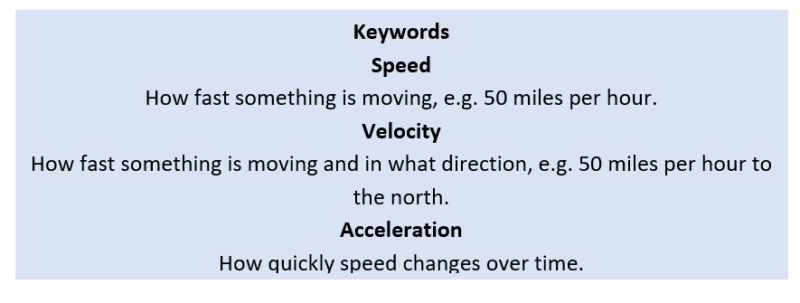In this post
Kinematics is just a fancy name for the study of motion and the way that things move around. It is therefore related to things like speed and acceleration. Most people think that the terms ‘speed’ and ‘velocity’ are interchangeable but really they do have differences.
Scalars and vectors
Scalars and vectors will be discussed in much greater detail later in the chapter but it is important that you understand what these two quantities are and how they differ. Scalar quantities are those which only take account of only a numerical value with no indication as to the direction of movement.
Speed is an example of a scalar value as speed is concerned only with how fast something travels and is represented as only a number with no indication as to the direction in which the object is travelling.
Vector quantities are those which take into account the numerical value and the direction of movement. Velocity is an example of a vector quantity as it takes into account the speed at which the object is moving as well as the direction of movement.
Velocity is therefore linked closely to displacement and can be calculated by the equation below:
![Rendered by QuickLaTeX.com \[ \text{velocity} = \frac{\text{increase in displacement}}{\text{time taken}} \]](https://b3801007.smushcdn.com/3801007/wp-content/ql-cache/quicklatex.com-762e9d7dac6e019a8ff5e78ed3058fb9_l3.png?lossy=2&strip=1&webp=1)
As they are linked to direction, both displacement and velocity can have negative gradients when plotted on a graph. On a velocity-time graph, this is seen when the velocity of something is decreasing.
Acceleration
Acceleration is a measurement of how much the velocity of an object increases over a given time period. Acceleration is calculated using the equation:
![Rendered by QuickLaTeX.com \[ \text{Acceleration} = \frac{\text{change in velocity}}{\text{time}} \]](https://b3801007.smushcdn.com/3801007/wp-content/ql-cache/quicklatex.com-a3963da68df8c081899d41f8418c4f80_l3.png?lossy=2&strip=1&webp=1)
(You must know and be able to rearrange the equation used to calculate acceleration.)
The acceleration of an object depends on two things – how much the velocity changes and the time it takes to change.
Calculating the change in velocity
The change in velocity is calculated by subtracting the velocity at the start from the velocity at the end of the movement. For example, if we have a bus that travels at 30 m/s then accelerates to a speed of 50 m/s as it approaches a motorway, the change in velocity is 20 m/s. If this increase in speed occurs over the course of 10 seconds, the acceleration of the bus can be calculated as:
![Rendered by QuickLaTeX.com \[ \text{Acceleration} = \frac{20m/s}{10 s} = 2 m/s^2 \]](https://b3801007.smushcdn.com/3801007/wp-content/ql-cache/quicklatex.com-745917ef9e2afb10e454dd238249ce40_l3.png?lossy=2&strip=1&webp=1)
The answer we get here is 2 m/s^2 which is said as ‘2 metres per second per second’. This means that the speed of the bus increases by 2 m/s every second during the time it approaches the motorway.

It is sometimes easier to write the equation for acceleration a little differently. This is shown as:
![Rendered by QuickLaTeX.com \[ a = \frac{(v-u)}{t} \]](https://b3801007.smushcdn.com/3801007/wp-content/ql-cache/quicklatex.com-776f61b25f070c3350580c017544f818_l3.png?lossy=2&strip=1&webp=1)
Where a = acceleration, v = final velocity, u = initial velocity, t = time
In this equation we have acceleration being equal to the final velocity minus initial velocity over time. This calculation of final velocity minus initial velocity simply works out the difference in velocity that we have. Much like velocity, acceleration is a vector, as the direction of movement is also important.
Acceleration units
An acceleration or deceleration is written with units of ms-2 which is said as ‘metres per second per second’. The units that are used can be very confusing so we should just remember the following:
| Calculation | Units (with metres) |
| Distance | m |
| Speed | ms-1 |
| Acceleration | ms-2 |
Deceleration
Deceleration is found on a velocity-time graph when the line has a negative gradient. As already explained, this does not mean that the object is travelling in a different direction to what it would be if the line were positive. We are still travelling in the same direction; we are just slowing down. This can be thought of as applying the brakes in a car which causes your velocity to decrease.
Uniform motion
Uniform motion is motion at a constant speed. For an object travelling with uniform motion, there is zero acceleration. This means that the initial and final speeds at which an object travels will be equal.
This relationship is shown using the equation:
![Rendered by QuickLaTeX.com \[ (\text{final speed})^2 = (\text{initial speed})^2 + (2 \times \text{acceleration} \times \text{distance moved}) \]](https://b3801007.smushcdn.com/3801007/wp-content/ql-cache/quicklatex.com-c98783b82a66efbdb0abec38281d86c7_l3.png?lossy=2&strip=1&webp=1)
![Rendered by QuickLaTeX.com \[v^2 = u^2 + (2 \times a \times s) \]](https://b3801007.smushcdn.com/3801007/wp-content/ql-cache/quicklatex.com-47467a74ed23fff4a9e2501cfd77df48_l3.png?lossy=2&strip=1&webp=1)
If there is zero acceleration, the value (2 x 0 x distance moved) from the equation becomes a zero value and can therefore be ignored. As the equation shows, this then means that the (final speed)2 = (initial speed)2.
When the forces acting on the object change, the acceleration of the object changes and the final speed and initial speeds are no longer equal.



